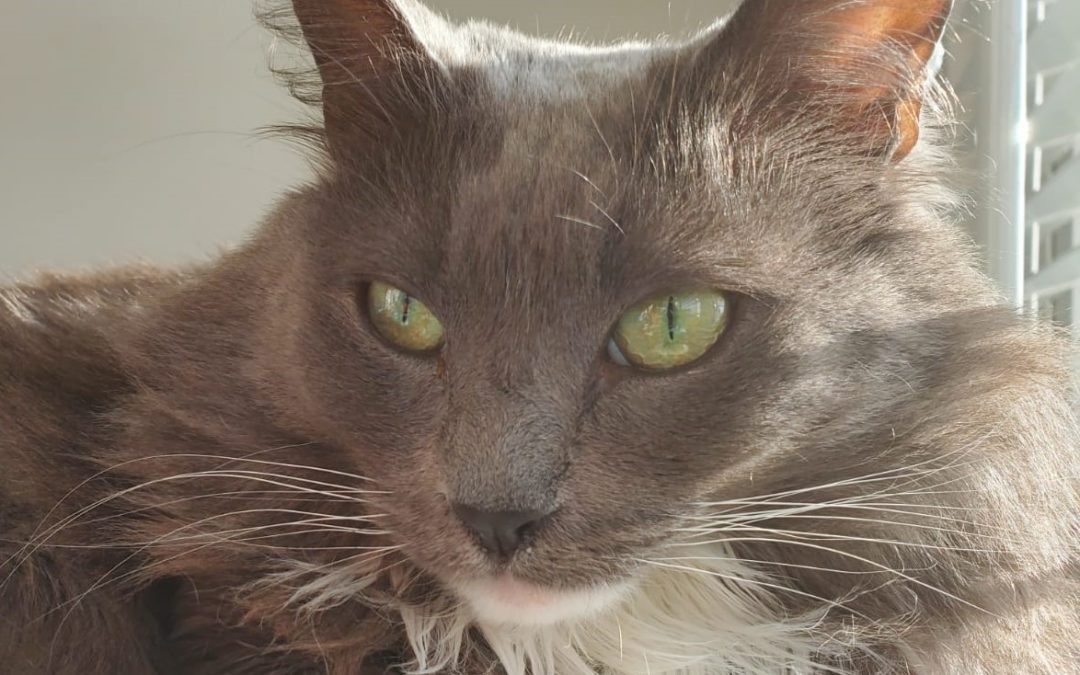The whiskering world of cat speak: What do they mean?
K.J. Johll
The biggest task I face when helping cat whose owner has reached out to me is understanding their language. My hope when I meet a cat is that not only will I understand them but I’ll also leave them with an owner who better understands them too.
While we often consider the “meow” as cat speak, it’s only a very small part of it. As a matter of fact, cats ONLY developed the meow as a way to speak to US, their humans. They rarely make noise when communicating with each other and they generally prefer to not make noise when communicating with us.
So where’s that leave us? Mind reading? Well, that’s not a skill I have so let’s start instead with the whiskers!
Whiskers may be adorable but they’re actually a vital part of a cat’s every move. They are generally as wide as the cat so that they can sense whether they will fit into certain spaces. (Their fancy named is vibrissae if you ever want to impress the room with your cat knowledge.)
When it comes to knowing your cat, know their whiskers! Whiskers, along with ears, eyes and body language, make up the entire cat language.
Here are a few ways to better understand your cat, just by watching the whiskers:
#1 Relaxed Whiskers = Relaxed Cat: When the cat is relaxed, the house is relaxed. Cats pick up all the vibes. They’re very in tune with the energy and mood around them. When their whiskers are relaxed, enjoy and know you’re providing a safe space for your furry friend. Celebrate your achievement!
Cats are prey in the wild as well as predators so relaxing for them is about as easy as it is for us when we’re working multiple jobs, juggling e-learning and riding out a pandemic. Yeah, basically, your cat is always feeling what we feel now. If you have a relaxed cat, you get an award.
#2 Whiskers Back: When feeling threatened, a cat’s whiskers will be back against their face. You may notice their ears back too as additional warning. They are generally sending the message “stay back.” Any type of fear or anxiety and a cat will generally pull the whiskers back.
If there’s nothing noticeable to you that would be an immediate threat, pay attention as they may be feeling vulnerable due to illness. Always consult the vet if anything about your cat’s behavior is off.
Human side note: Wouldn’t it be nice to have whiskers to tell people to leave you alone when you need space? Or is that just my introverted self who likes this idea?
#3 Whiskers Forward: Oh, your cat is INTERESTED! You’ll notice this when you shake their favorite toy! Those whiskers practically point right at it! When the whiskers are forward, you have your cat’s attention. It may be a positive thing as in “Let’s play!” or “Oh, that bacon you’re making smells good!” but it can also signal offensive aggression in times of stress or on the hunt. In this case, their eyes may be wide and zooming in too.
There are many subtle ways in between these three states that our cats are communicating with us using their whiskers and body language. And guess what? They have NO idea that we don’t understand them.
Want help understanding your cat? Let’s talk!
Warm wishes and whisker love,
KJ
Your Kitty Correspondent
KJ can be seen sharing positive stories about cats regularly on Pet Pals TV! She has spent her entire life “raising cats” from her beginnings on a farm to over 10 years working in a cat clinic. She now works to improve feline lives by supporting shelters, rescues and providing guidance to cat lovers experiencing behavior issues or in need of help speaking their cat’s language. Want to make the story of your cat a positive one? Contact KJ here for a Kitty Konsultation.


